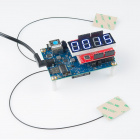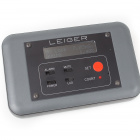AngusP
Member Since: December 2, 2010
Country: United Kingdom
-
For more information on these plugs, they are GX16 6pin, which seem to be the same thing as CBC 6 connectors.
-
Adafruit have a lot of content on how to deal with these (they call them 'NeoPixels'). They recommend powering them in 1m lengths, so connect every metre. 20A will be fine driving 5m of these at peak.
-
I think you can use something like 6 conductor trailer cable - It's fairly high gauge so should fit snugly.
-
Anyone running this at 3.3v without issues?
-
I think RoHS is an optional but suggested guideline for manufacturers in the EU- I've at least never had a shipment blocked at import to the UK because of no RoHS
-
It looks like there isn't much point in coding on this board with arduino - much better to use an SD card & write code in C that can make full use of the board's IO & speed (Given that some people are claiming this is about 200 times SLOWER than an AVR based arduino)
-
I'd use GPS and Barometric to cross reference and get a more accurate altitude. I'd use a IMU for vario as it's a small measurement and very finnicky, and GPS would have a fair bit of uncertainty, noise and lag unless you're diving or climbing at around 5 feet/second or more (as a guess). Also, if you've got an IMU then you can easily include an artificial horizon, which isn't a common instrument in a glider but would give you accurate bank angle readings. Having GPS is important for accurate time calculations, i.e. IAS and variometer's feet per second.
-
In that third last picture - are they gas masks on the ground? It's quite a chilling image.
-
If you have a 3.3v that is the system voltage - a digital input at 3.3v will read high, and of course 0v will read low. The I2c and all of it's output is at 3.3v - and if you have sensors that run at 3.3v (a lot of delicate ones do!) then you can plug them straight in, and they'll be fine. On the other hand, the 5v version runs at 5v, so for it HIGH means 5v, not 3.3v. So if you plug your 3.3v sensors straight into a 5v arduino, you're likely to toast them and make the magic blue smoke come out. The advantages of the 3.3v are that it uses less power and can talk directly to 3.3v sensors, and the advantage of the 5v is it has a faster clock frequency, an can talk straight to a 5v sensor.
I hope that helps...!
-
This is pretty awesome for people trying to develop Arduino code in places where GUIs might not be too practical (like on a server, or Raspberry Pi)












































